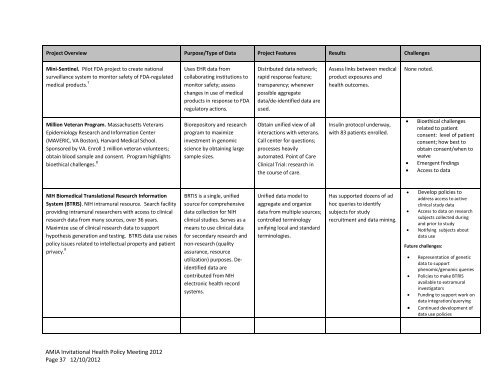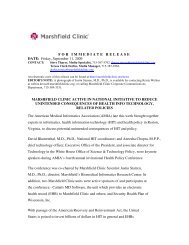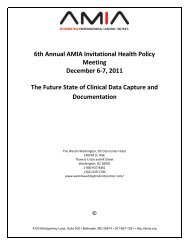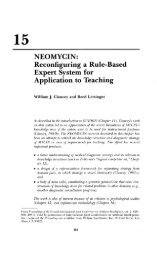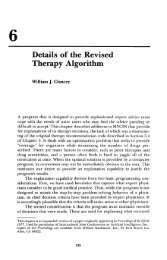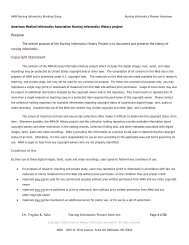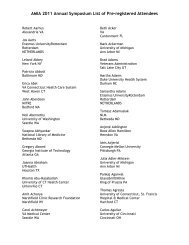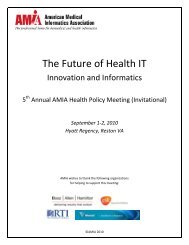7th Annual AMIA Invitational Health Policy Meeting December 12-13 ...
7th Annual AMIA Invitational Health Policy Meeting December 12-13 ...
7th Annual AMIA Invitational Health Policy Meeting December 12-13 ...
You also want an ePaper? Increase the reach of your titles
YUMPU automatically turns print PDFs into web optimized ePapers that Google loves.
Project Overview Purpose/Type of Data Project Features Results Challenges<br />
Mini-Sentinel. Pilot FDA project to create national<br />
surveillance system to monitor safety of FDA-regulated<br />
medical products. 7<br />
Million Veteran Program. Massachusetts Veterans<br />
Epidemiology Research and Information Center<br />
(MAVERIC, VA Boston), Harvard Medical School.<br />
Sponsored by VA. Enroll 1 million veteran volunteers;<br />
obtain blood sample and consent. Program highlights<br />
bioethical challenges. 8<br />
NIH Biomedical Translational Research Information<br />
System (BTRIS). NIH intramural resource. Search facility<br />
providing intramural researchers with access to clinical<br />
research data from many sources, over 36 years.<br />
Maximize use of clinical research data to support<br />
hypothesis generation and testing. BTRIS data use raises<br />
policy issues related to intellectual property and patient<br />
privacy. 9<br />
<strong>AMIA</strong> <strong>Invitational</strong> <strong>Health</strong> <strong>Policy</strong> <strong>Meeting</strong> 20<strong>12</strong><br />
Page 37 <strong>12</strong>/10/20<strong>12</strong><br />
Uses EHR data from<br />
collaborating institutions to<br />
monitor safety; assess<br />
changes in use of medical<br />
products in response to FDA<br />
regulatory actions.<br />
Biorepository and research<br />
program to maximize<br />
investment in genomic<br />
science by obtaining large<br />
sample sizes.<br />
BRTIS is a single, unified<br />
source for comprehensive<br />
data collection for NIH<br />
clinical studies. Serves as a<br />
means to use clinical data<br />
for secondary research and<br />
non-research (quality<br />
assurance, resource<br />
utilization) purposes. Deidentified<br />
data are<br />
contributed from NIH<br />
electronic health record<br />
systems.<br />
Distributed data network;<br />
rapid response feature;<br />
transparency; whenever<br />
possible aggregate<br />
data/de-identified data are<br />
used.<br />
Obtain unified view of all<br />
interactions with veterans.<br />
Call center for questions;<br />
processes heavily<br />
automated. Point of Care<br />
Clinical Trial: research in<br />
the course of care.<br />
Unified data model to<br />
aggregate and organize<br />
data from multiple sources;<br />
controlled terminology<br />
unifying local and standard<br />
terminologies.<br />
Assess links between medical<br />
product exposures and<br />
health outcomes.<br />
Insulin protocol underway,<br />
with 83 patients enrolled.<br />
Has supported dozens of ad<br />
hoc queries to identify<br />
subjects for study<br />
recruitment and data mining.<br />
None noted.<br />
� Bioethical challenges<br />
related to patient<br />
consent: level of patient<br />
consent; how best to<br />
obtain consent/when to<br />
waive<br />
� Emergent findings<br />
� Access to data<br />
� Develop policies to<br />
address access to active<br />
clinical study data<br />
� Access to data on research<br />
subjects collected during<br />
and prior to study<br />
� Notifying subjects about<br />
data use<br />
Future challenges:<br />
� Representation of genetic<br />
data to support<br />
phenomic/genomic queries<br />
� Policies to make BTRIS<br />
available to extramural<br />
investigators<br />
� Funding to support work on<br />
data integration/querying<br />
� Continued development of<br />
data use policies


